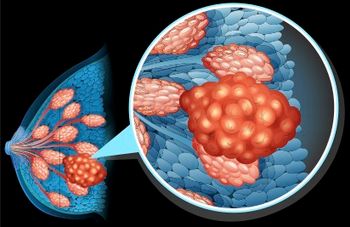
PET Imaging Agent Earns FDA Fast Track Designation in Recurrent Glioma
TLX101 is currently under assessment as a treatment for glioma in the IPAX-2 and IPAX-Linz studies.
The FDA has granted fast track designation to TLX101-CDx (18F-floretyrosine; 18F-FET; Pixclara), a PET imaging agent, for use in progressive or recurrent glioma, according to a press release from developers Telix Pharmaceuticals Limited.1
Developers are close to finishing their preparations to submit a new drug application to the FDA for TLX101-CDx in the aforementioned indication for both pediatric and adult patients. According to the press release, there are currently no commercially available targeted PET agents for brain cancer imaging that have received approval from the FDA in the United States.
“There is a critical unmet need to improve the diagnosis and management of glioma, particularly in the post-treatment setting, and we are excited to leverage the clinical experience at the University of California, San Francisco [UCSF] to help make this investigational agent more widely available,” Thomas A. Hope, MD, a professor of radiology at UCSF, said in the press release.1 “18F-FET has the potential to help determine if a glioma is truly progressing or undergoing a treatment-induced change, known as pseudo-progression, where MRI—the standard of care—can often be inconclusive.”
Developers designed TLX101-CDx to target LAT1 and LAT2, thereby enabling its use as a companion diagnostic to TLX101 (4-L-[131I] iodo-phenylalanine; 131I-IPA). The FDA previously granted orphan drug designation to TLX101-CDx for use in the treatment of patients with glioma in October 2020.2
Investigators are currently evaluating treatment with TLX101 for patients with glioma as part of the phase 1 IPAX-2 trial (NCT05450744) as well as the phase 2 IPAX-Linz study.
IPAX-2
In the dose-escalation phase 1 IPAX-2 trial, investigators are assessing the safety of TLX101 plus external beam radiation therapy (EBRT) and temozolomide (Temodar) among patients with frontline glioblastoma.3 The trial is expected to include 12 patients to determine whether the safety and drug interaction profile of TLX101 is acceptable in this setting before developers proceed with a proof-of-concept phase 2 trial.
Developers announced that the first patient had received a dose of study treatment in August 2023.
“Promising efficacy data observed in IPAX-1 [NCT03849105] warrants further investigation in an earlier setting,” principal investigator Josef Pichler, a professor at Kepler University Hospital in Austria, said in a press release at the time of the first patient receiving a dose.3 “We are therefore pleased to be exploring Telix's glioblastoma therapy candidate in newly diagnosed patients, to accelerate development in this underserved disease area with few effective treatment options.”
The trial’s primary end points are the incidence and severity of dose-limiting toxicities as well as safety, tolerability, and the recommended phase 2 dose.4 Patients 18 to 65 years old with histologically confirmed intracranial glioblastoma following surgical resection and a Karnofsky performance status of 70 or higher are eligible for enrollment on the trial. Additional eligibility criteria include having no prior systemic therapy or radiotherapy for glioblastoma.
IPAX-Linz
Developers announced that the first patient had received study treatment as part of the IPAX-Linz trial in November 2022.5 In this trial, investigators are evaluating TLX101 plus EBRT in patients with recurrent high-grade glioma, including those with glioblastoma multiforme.
The trial will include an estimated recruitment of 10 patients with the goal of collecting additional data on the clinical utility of TLX101 in this population. Additionally, it is intended to run concurrently with the IPAX-2 trial.
“We are pleased to have commenced the IPAX-Linz study, which alongside IPAX-2 supports Telix's goal to expedite the development of a potential new therapy in an aggressive cancer with poor prognosis,” Colin Hayward, MD, chief medical officer at Telix Pharmaceuticals, said in a press release.5
References
- TLX101-CDx (Pixclara™) granted FDA fast track designation. News release. Telix Pharmaceuticals Limited. April 15, 2024. Accessed April 17, 2024. https://tinyurl.com/2fu33ryy
- Telix granted FDA orphan drug designation for glioma imaging agent. News release. Telix Pharmaceuticals Limited. October 6, 2020. Accessed April 17, 2024. https://tinyurl.com/yhuptjzk
- First patient dosed in IPAX-2 study of TLX101 brain cancer therapy candidate in patients with newly diagnosed glioblastoma. News release. Telix Pharmaceuticals Limited. August 8, 2023. Accessed April 17, 2024. https://tinyurl.com/4swm89sy
- 131I-TLX-101 for treatment of newly diagnosed glioblastoma (IPAX-2) (IPAX-2). ClinicalTrials.gov. Accessed April 17, 2024. https://tinyurl.com/yc52sdun
- First patient dosed in phase II 'IPAX-Linz' study of TLX101 for glioblastoma therapy. News release. Telix Pharmaceuticals Limited. November 21, 2022. Accessed April 17, 2024. https://tinyurl.com/55wjdsd5
Newsletter
Stay up to date on recent advances in the multidisciplinary approach to cancer.



















































































